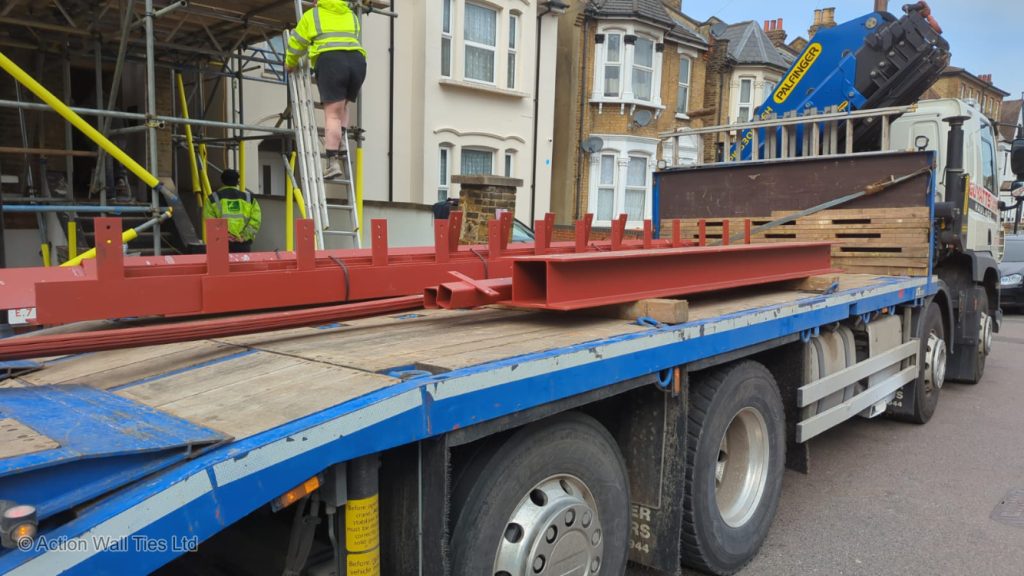Customer Stories
Learn about our previous projects, filter by property type, defect and our solution for each
Learn about our previous projects, filter by property type, defect and our solution for each
This 4-storey period property in Stratford, East London had been converted into flats. The large brick flank wall had significant outward bulging, with corresponding internal movement, resulting in cracking in the front and rear elevations. Without prompt structural repairs, the defect would worsen causing the property to be condemned as unsafe for occupation.
The owners and their structural engineers contacted Action Wall Ties to assist in designing and completing structural remediation works. Action Wall Ties, working with the consulting structural engineers, designed a practical stabilisation method that maintained the internal layouts.
This semi-detached Victorian/Edwardian property in London had been converted into a house of multiple occupation (HMO). The building had undergone extensive internal remodelling, including the complete removal of the original central spine wall, which had been replaced with steel beams. A survey found visible outward bulging of the large brick side wall, plus internal movement and cracking in the front and rear elevations.
As with many properties with structural defects, previous repair attempts had provided only short-term, cosmetic repairs but failed to tackle the underlying issues. As shown in the photo, the brickwork had bulged by well over 2 inches/5cm between floors.
Consulting structural engineers reported that the central spine wall had been removed at the upper ground, first, and second-floor levels. The floors have been re-supported with steel beams. Originally, the central wall would have acted as a shear wall, providing horizontal stability to the building and preventing it from raking/leaning. Its removal has meant inadequate provision for horizontal stability in the central part of the building. This situation is believed to contribute to or worsen the bowing in the flank wall, presenting a significant structural problem that jeopardizes the building’s integrity. If not addressed, this issue is expected to worsen, potentially making the building a safety risk to the occupants.
Action Wall Ties, working with the consulting structural engineers, designed a practical stabilisation method that maintained the internal layouts of the flats. This involved forming braced diaphragms on each floor, incorporating the existing replacement steel beams, and introducing fabricated steel angles with welded junctions at ceiling line perimeters. This method reinstated horizontal stability to the central area in compliance with Document A of the building regulations regarding disproportionate collapse.
AWT worked with the structural engineer to design the steel work which was fabricated and delivered to the site. This allowed the on-site structural steelwork and brickwork to be completed in 2 weeks.

The consulting engineers initially recommended two options to restore horizontal stability to the central area of the building while maintaining the internal layouts. However, both options would be disruptive, requiring tenants to move out for an extended period during the work. The owners were keen to find a solution that would not require changing the floor plan of the flats, as this would lead to additional costs and impact the sale/rental values.
The first option suggested by the consulting engineers was to install a three-story steel frame throughout the building, providing the necessary horizontal stiffness. If the existing beams were perfectly aligned (which is unlikely), it might be possible to use them with steel posts installed between them. However, misalignment of at least one beam is probable, leading to non-vertical posts. The second option was to rebuild the central spine wall in blockwork, possibly retaining the existing beams. This option would alter the layouts of the upper flats. It was noted that tying the flank wall to the floor plates and walls would be pointless without addressing the shear wall problem, necessitating both measures to stabilize the building. AWT collaborated with the consulting engineers to find a long-term, cost-effective structural repair solution that minimises disruption to the tenants.
Working with the consulting structural engineers, Action Wall Ties collaboratively designed a practical method of forming braced diaphragms on each floor. This method incorporated the existing replacement steel beams and involved adopting fabricated steelworks welded in situ. This approach maintained the benefits of the internal layouts while reinstating horizontal stability in the central area, in accordance with Document A concerning the disproportionate collapse of the building.
The steel braces restored the structural integrity of the building and realigned the brickwork. The property was left ready for the reinstatement of the internal finishes. Once replastering, repainting etc was completed, no fixings were visible inside or outside the property. AWT provided a long-term structural repair that preserved the floor plan of the flats and protected their sale/rental values.
Action Wall Ties are specialist structural repair contractors with the knowledge and experience required to repair period properties with severe masonry defects, such as bulging brick walls. AWT work with structural engineers, property owners, architects, project managers and local authorities on both small and large projects.
AWT are available across London, Kent, Essex, Surrey and Sussex. To arrange a survey or to discuss project details, please use our contact form, email us or call us on 01227 721 255.
Our specialist structural repair contractors will be happy to help provide a comprehensive and permanent repair to your structural problems.





